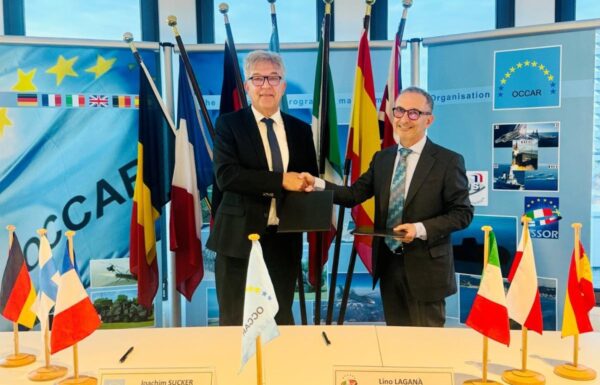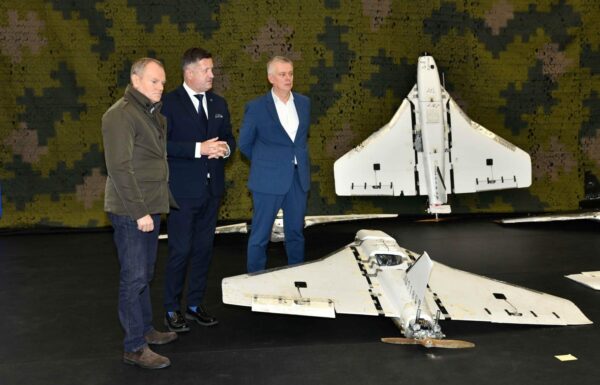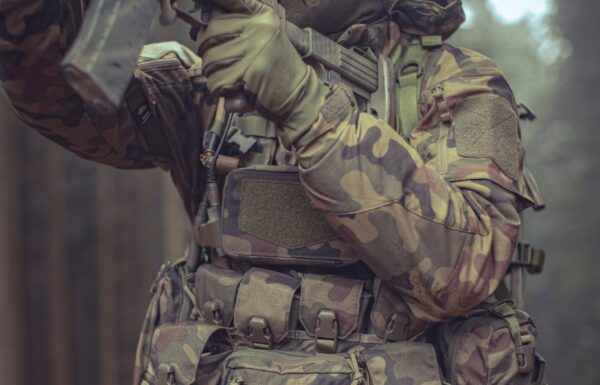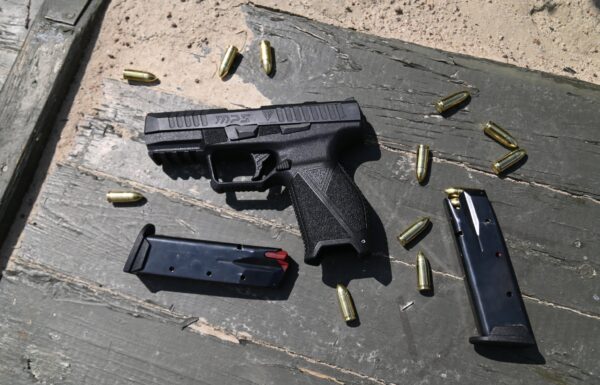Land-and-Naval SA-35
The idea to develop the SA-35 originated independently within PIT-Radwar, without any external commission. The implementation of the OSU-35K naval weapon system with a 35 mm gun on minehunters brought with it ready-made solutions proven in harsh maritime conditions. It was concluded that the already developed AM-35K gun could be relatively quickly adapted to land-based requirements. The new design therefore uses the complete turret of the AM-35K naval gun, the ZGS-35K observation and tracking head, electronics modules from the BSKO-35K system, and the RSKO-35K backup fire control station. The main components are mounted on a platform the size of a standard 20-foot container, making it transportable by any vehicle designed to carry such containers.
 The SA-35 gun is the result of a concept developed at PIT-Radwar that the existing AM-35K naval gun could be relatively quickly adapted to land-based requirements / Photo: PIT-Radwar
The SA-35 gun is the result of a concept developed at PIT-Radwar that the existing AM-35K naval gun could be relatively quickly adapted to land-based requirements / Photo: PIT-Radwar
The prepared demonstrator is intended to show potential customers that it is possible to relatively quickly develop a product based on existing solutions, which shortens the time between placing an order and receiving the final result. Of course, in creating the SA-35, PIT-Radwar acted without any — even preliminary — requirements from a potential client, let alone detailed tactical and technical specifications. It must be emphasized that at this stage, it is a demonstration of the company’s capabilities rather than a finished, mature product. However, this does not mean that such a demonstrator is merely a trade show exhibit.
After last year’s MSPO, in the first half of October 2024, the SA-35 was sent to the Central Air Force Training Range in Ustka to verify the adopted design assumptions through live-fire testing. Trials were conducted during which nearly 500 rounds were fired.
 W nowej konstrukcji wykorzystano kompletną wieżę morskiej armaty AM-35K i głowicę obserwacyjno-śledzącą ZGS-35K, bloki elektroniki z BSKO-35K oraz rezerwowe stanowisko kierowania ogniem RSKO-35K / Zdjęcie: Jakub Link-Lenczowski, MILMAG
W nowej konstrukcji wykorzystano kompletną wieżę morskiej armaty AM-35K i głowicę obserwacyjno-śledzącą ZGS-35K, bloki elektroniki z BSKO-35K oraz rezerwowe stanowisko kierowania ogniem RSKO-35K / Zdjęcie: Jakub Link-Lenczowski, MILMAG
According to the designers, the tests fully confirmed that the selected Jelcz P663.45 T60 chassis (which, incidentally, is itself a prototype) proved effective in practice — both in terms of off-road mobility and stability during firing. No major failures occurred on either the chassis or the gun side. Of course, these were not endurance tests, so it is difficult to draw definitive conclusions, but it can be said that no concerning symptoms were observed that would suggest this combination of chassis and gun might face serious durability issues.
>>>PGZ presents the capabilities of the SA-35 artillery air defense system<<<
When firing with the use of stabilizing supports, the results fully matched those achieved by the naval version. An even more important test involved firing without supports, meaning all vibrations were transferred directly to the vehicle chassis. It turned out that the resulting platform movements could be compensated for without making any modifications to the gun’s existing drive system. This opens the possibility of effective fire from short halts, allowing for flexible responses to changing air situations—even while the vehicle is on the move.
Naturally, this raises the question of the potential to fire while in motion. In this case, the manufacturer is cautious in making claims, as verifying such a capability requires practical tests with all the necessary measurements. Firing on the move is a much more complex issue than just stabilizing the gun. For example, it requires the ability to receive accurate target data from external sources, which in turn demands precise knowledge of the fire unit’s position relative to the detection systems. This problem can, of course, be solved by mounting both the weapon and detection systems on the same chassis. However, this would constitute an entirely new design, inevitably approaching a concept similar to the Loara system, which was abandoned nearly two decades ago.
 The completed demonstrator was publicly presented during MSPO 2024 in Kielce / Photo: Przemysław Gurgurewicz, MILMAG
The completed demonstrator was publicly presented during MSPO 2024 in Kielce / Photo: Przemysław Gurgurewicz, MILMAG
It should be noted that during the tests conducted in Ustka, the SA-35 did not operate independently. For the purposes of the trials, an improvised command system was created. The Bystra radar station was used to designate targets, and the data was transmitted via a version of the Zenit system adapted for the test.
Last year’s tests in Ustka give the designers reason to be optimistic about the potential final outcome. This year, improvements are planned along with another round of live-fire range tests. However, no changes to the current configuration are planned. Since the entire project is funded from PIT-Radwar’s own resources, and in the absence of specific requirements from a potential user, further development work will be limited for financial reasons.
 The SA-35 uses the complete turret of the AM-35K naval gun, which was previously mounted on ORP Albatros / Photo: Jakub Link-Lenczowski, MILMAG
The SA-35 uses the complete turret of the AM-35K naval gun, which was previously mounted on ORP Albatros / Photo: Jakub Link-Lenczowski, MILMAG
An example of what the final SA-35 could look like was shown in earlier visualizations, which depicted a platform equipped with four stabilizing supports. In addition to the gun, it featured an observation and tracking head mounted on a telescopically extendable mast, electronic modules, a communications and data transmission subsystem, and an autonomous power supply system in the form of a generator. Mounting all components on a single platform would also allow for autonomous operation without the vehicle, which could be useful for better concealment of the gun in the field or for the defense of stationary targets. Additionally, the use of the RSKO-35K backup fire control station—known from naval applications—in a remote configuration would allow the gun to be operated from a safe distance, thus reducing the risk to the crew in the event of an attack on the weapon itself.
 Photo: Jakub Link-Lenczowski, MILMAG
Photo: Jakub Link-Lenczowski, MILMAG
Naturally, the demonstrator does not have all the capabilities that could be implemented in a production variant. The final configuration would, if needed, be based on the precise requirements of the end user. The load capacity of the Jelcz P663.45 T60 chassis currently provides a sufficiently large margin to accommodate not only the gun itself, but also a larger ammunition supply or even a fire control radar.
Such a device is currently being developed at the Gdańsk branch of the company under the codename Tuga. This compact X-band radar is expected to have a range of around 20 km against large targets, while for small targets like mini drones (with a radar cross-section of 0.01 m²), it would offer a detection range of 3–4 km. Thanks to its panel-based design, it can also be configured into a 360-degree radar, capable of functioning not only as a fire control radar, but also—within certain limits—as a target acquisition radar.
 Photo: Jakub Link-Lenczowski, MILMAG
Photo: Jakub Link-Lenczowski, MILMAG
Although the SA-35 demonstrator is intended to showcase the possibility of creating a product that can be easily adapted to customer requirements, certain potential applications for such a gun can be identified. One idea is to incorporate it into the Pilica+ air defense missile-artillery system. Under current plans, this system is to include ZUR-23-2SP artillery-missile sets and CAMM short-range missile launchers. Compared to the original requirements of the Pilica program, the scope of use has been expanded, which also led to an increase in the total number of ordered batteries from 6 to 22.
While the original Pilica system was primarily intended for the defense of stationary assets (e.g., airfields), Pilica+ has also been tasked with providing cover and supplementing the fire zones of the medium-range Wisła system (the Polish version of the Patriot PAC-3). For this purpose, Pilica+ is to be enhanced with subsystems for countering aerial munitions and unmanned aerial vehicles. In this context, the ability to use airburst programmable ammunition—something feasible with a larger caliber gun—could be particularly valuable. This contrasts with the 23 mm rounds used in the ZUR-23-2SP, which are limited to conventional airburst types.
 ZGS-35K observation and tracking head / Photo: Jakub Link-Lenczowski, MILMAG
ZGS-35K observation and tracking head / Photo: Jakub Link-Lenczowski, MILMAG
Naval AM-35K
When discussing the SA-35, it is impossible not to mention its direct predecessor, the AM-35K, or more broadly, the OSU-35K system. The SA-35 development was based on the prototype AM-35K gun, which was temporarily installed on the minehunter ORP Albatros, while the first serially produced gun was delivered to ORP Mewa. It was on that vessel that improvements were introduced, based on lessons learned during the first months of operation. These changes do not affect the system’s core parameters but relate to operational aspects of the gun, such as user ergonomics. Meanwhile, PIT-Radwar is carrying out work aimed at optimizing the design for serial production—i.e., improving manufacturability. This is intended to streamline mass production of the OSU-35K system, though the changes may not be visible to an outside observer.
Currently, six sets of the new systems have been ordered: one for ORP Albatros to replace the prototype originally tested on it, three for newly built project 258 minehunters, and two for the first multi-role frigate of the project 106 Miecznik. There are also plans for four additional sets—two for the second and third Miecznik-class ships, and possibly one more if a decision is made to fully upgrade the prototype ORP Kormoran to the serial production standard. The AM-35K gun in the Miecznik variant will not differ from those used on the Kormoran II class. The only potential change could be a lower mounting base, as the original was designed to fit the dimensions of minehunters, while on frigates it can be considerably lower.
Still pending implementation is the programmable ammunition system for the OSU-35K. All AM-35K guns are structurally prepared to fire this type of ammunition and only require the installation of a muzzle device containing three coils—two for measurement and one for programming—a power and programming module, and a cable connecting them.
 The load capacity of the Jelcz P663.45 T60 chassis used in the SA-35 provides a large margin, allowing for an increased ammunition supply or the integration of a small fire control radar, such as the Tuga currently being developed by PIT-Radwar / Photo: Przemysław Gurgurewicz, MILMAG
The load capacity of the Jelcz P663.45 T60 chassis used in the SA-35 provides a large margin, allowing for an increased ammunition supply or the integration of a small fire control radar, such as the Tuga currently being developed by PIT-Radwar / Photo: Przemysław Gurgurewicz, MILMAG
The development of this type of domestic ammunition is currently being carried out under the research and development project titled “35 mm Programmable Ammunition System for the Naval Weapon System (OSU-35K) / SAP-35“. The project is being implemented by a consortium consisting of the Military University of Technology (leader), Mesko S.A., and PIT-Radwar, and is funded by the National Centre for Research and Development. The program, originally scheduled for the period from December 20, 2022, to June 20, 2025, has now been extended to December 2025. Its goal is to produce and test a prototype batch of 35 mm programmable ammunition for the OSU-35K under real conditions. This includes: developing a prototype of the 35 mm programmable ammunition system, manufacturing a prototype batch for testing, conducting preliminary and qualification tests of the SAP-35 prototype, and developing firing tables and technical documentation for the product.
As part of the program, in addition to the programmable airburst projectile itself, the following components are also being developed: the aforementioned muzzle device for the gun with an integrated measuring and programming system, and a specialized velocity measurement and programming computer that interfaces with the fire control system. One remaining task is the proper adaptation of the fire control system software. Once the new ammunition is introduced, a new ballistic module will be required, along with a module to calculate airburst parameters, so as to optimize fragment density depending on the type of target—be it an aircraft or a large or small unmanned aerial vehicle. All of this will be implemented into the OSU-35K system upon completion of the SAP-35 program.
Predecessors of the SA-35
The 35 mm KDA gun, for which a manufacturing license was purchased back in December 1995, has so far had little success being implemented in a land-based version in Poland. Originally acquired as the armament for the Loara self-propelled anti-aircraft system, it remained unused after the program was canceled. In the following years, various ideas emerged for how to make use of it.
 The key components of the SA-35 were mounted on a platform the size of a standard 20-foot container, making it transportable by any vehicle adapted for carrying this type of load / Photo: Jakub Link-Lenczowski, MILMAG
The key components of the SA-35 were mounted on a platform the size of a standard 20-foot container, making it transportable by any vehicle adapted for carrying this type of load / Photo: Jakub Link-Lenczowski, MILMAG
In 2007–2008, using components from the S-60M gun, a laboratory model of a towed gun named San-35 was developed. This work was continued in a development project titled “Remotely Controlled Anti-Aircraft System Based on a 35 mm Gun“. The project was carried out by a consortium consisting of the Military University of Technology (leader), CNPEP Radwar, and the Mechanical Equipment Research and Development Center in Tarnów. It began on December 22, 2009, and was scheduled to conclude on December 21, 2011. As a result, a gun known by the codename Hydra was created and successfully tested within the Navy’s Blenda artillery system. The firing tests conducted in 2011 became the foundation for initiating the development of a naval variant.
In December 2011, another attempt was made to develop a land-based variant. At that time, CNPEP Radwar submitted a project proposal titled “Anti-Aircraft Battery with 35 mm Guns“, which envisioned the use of towed guns in two variants: one with a programmable sight (A-35) and another with an individual electro-optical tracking and targeting head (AG-35). The complete system was also to include the MMSR-296 radar station, the WD-35 command and fire control vehicle, and 35 mm programmable ammunition. The developed components of the battery were presented for the first time in Kielce during MSPO 2016. However, the Polish military ultimately did not proceed with the purchase of the system.
 Photo: Jakub Link-Lenczowski, MILMAG
Photo: Jakub Link-Lenczowski, MILMAG
Later on, PIT-Radwar presented another concept for the use of 35 mm KDA guns. The proposed solution envisioned the development of a fully integrated very short-range air defense (VSHORAD) system, in which KDA guns could be mounted on various platforms depending on operational needs—such as the Rosomak wheeled armored personnel carrier, a tracked chassis derived from the K9PL/Krab self-propelled howitzer, or a heavy-duty off-road truck like the Jelcz P662. In the latter case, a demonstrator was built, consisting of an AG-35 gun mounted on a Jelcz P662.D43 chassis, which was showcased at MSPO 2021 in Kielce.
The SA-35 represents yet another approach to applying the 35 mm gun in a land-based role. Leveraging ready-made components from the naval version allows for the assumption that, in the case of an order for a variant equipped only with an electro-optical targeting head, a prototype for military testing could be delivered within 24 months of contract signing. For a version equipped with a radar-electro-optical sensors, the timeline would not exceed 36 months. The use of components from the OSU-35K naval system also means that the final SA-35 could be acquired through a ‘procurement with adaptation’ procedure, which is simpler than a full R&D project. Utilizing existing solutions certainly reduces technical risk and enables the customer to become familiar with the capabilities of a system already in service with the Navy. However, whether the SA-35 will attract customer interest and evolve into a serial product remains to be seen.
































